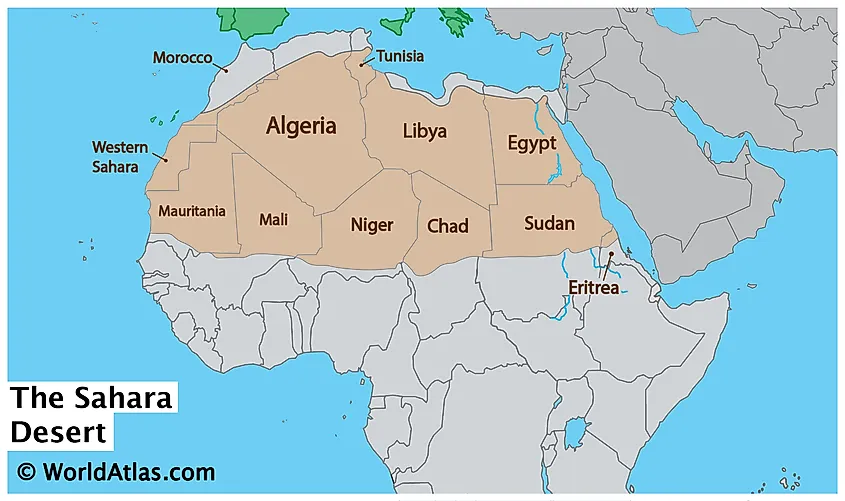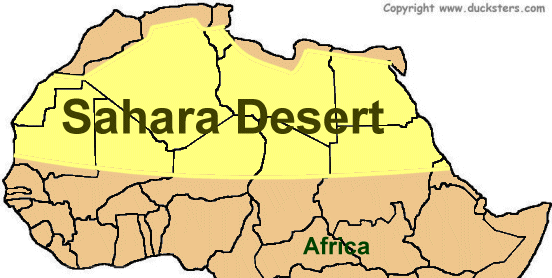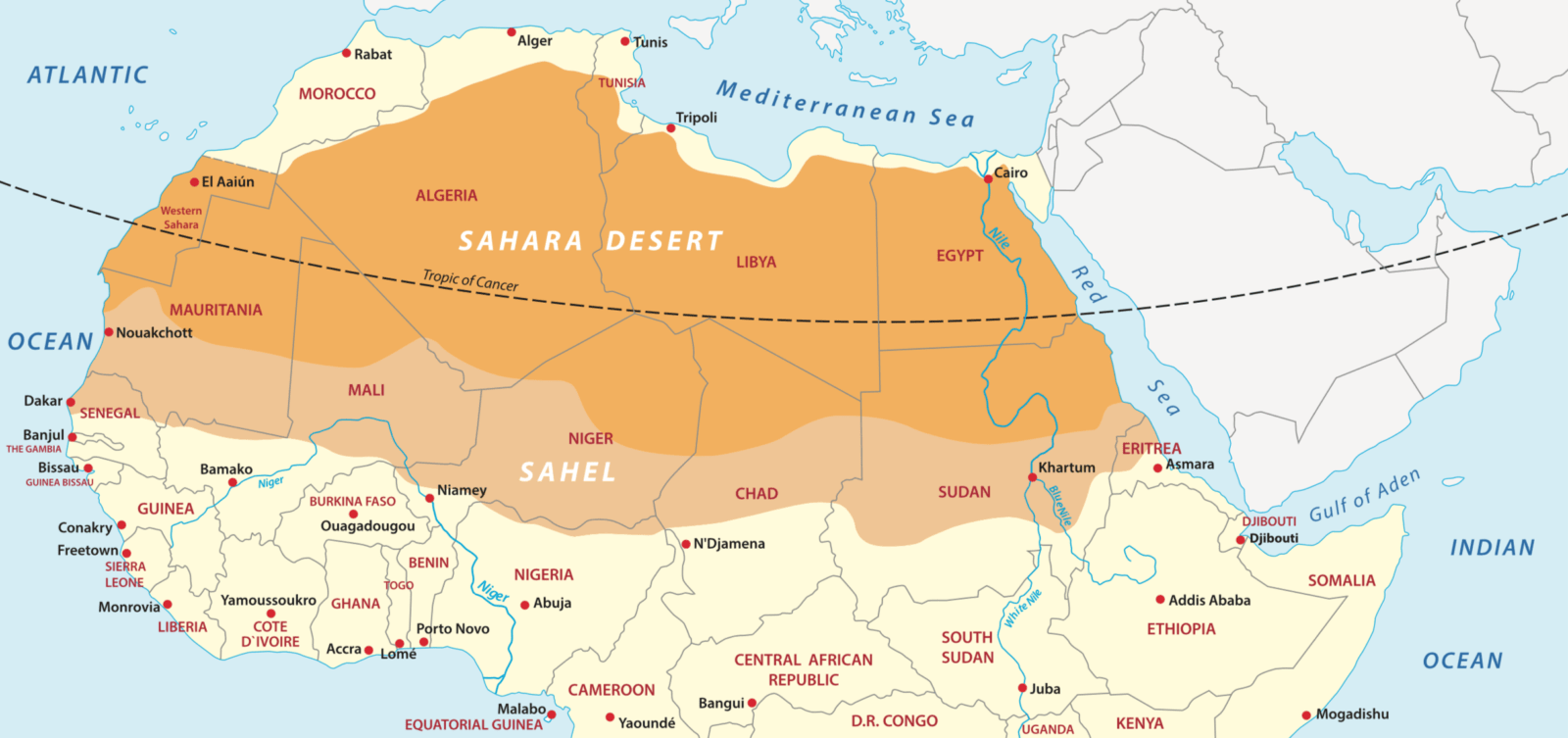Topic where is the sahara desert located in africa: Spanning across North Africa, the Sahara Desert is a marvel of nature, encompassing vast landscapes and diverse ecosystems. This article explores its grandeur, revealing why it"s a geographical wonder in the African continent.
Table of Content
- Where can I find the Sahara Desert in Africa?
- Geographical Location and Size
- Countries Encompassing the Sahara
- Ecological Regions Within the Sahara
- Climatic Conditions and Weather Patterns
- Flora and Fauna of the Sahara
- YOUTUBE: Faces of Africa: The Sahara
- Human Settlements and Cultures
- Topography and Physical Features
- Water Sources and Oases in the Sahara
Where can I find the Sahara Desert in Africa?
The Sahara Desert is located in northern Africa. It spans across several countries in this region, including:
- Algeria
- Chad
- Egypt
- Libya
- Mali
- Mauritania
- Morocco
- Niger
- Sudan
- Tunisia
- Western Sahara
The desert covers a vast area of approximately 9,200,000 square kilometers (3,600,000 square miles), making it the largest hot desert in the world.
It stretches from the Atlantic Ocean in the west to the Red Sea in the east and from the Mediterranean Sea in the north to the Sahel region in the south.
The Sahara Desert\'s location and unique features attract visitors from around the globe who are interested in exploring its vast landscapes and experiencing its extreme climate.
READ MORE:
Geographical Location and Size
The Sahara Desert, the world"s largest hot desert, is a vast and expansive landscape that stretches across North Africa. Encompassing approximately 9,200,000 square kilometers, it covers a significant portion of the continent, extending from the Red Sea in the east to the Atlantic Ocean in the west. This region includes parts of several countries such as Algeria, Chad, Egypt, Libya, Mali, Mauritania, Morocco, Niger, Sudan, Tunisia, and the disputed territory of Western Sahara.
Renowned for its harsh and challenging environment, the Sahara is characterized by a variety of landscapes including iconic sand dunes, rocky plateaus, and vast gravel plains. Despite the extreme aridity, the desert supports a range of ecosystems and is dotted with oases, providing crucial water sources. The topography features dramatic contrasts, from the lofty peaks like Chad"s Mount Koussi to the deep depressions like Egypt"s Qattera Depression.
With a hot desert climate, the Sahara experiences extreme temperatures and minimal rainfall. The northern fringes of the Sahara receive some winter rainfall due to Mediterranean influence, while the southern edges bordering the Sahel see more rain during summer months. Central Sahara is characterized by hyper-arid conditions, often receiving less than 50 millimeters of annual rainfall.
Historically, the Sahara has undergone significant climatic changes, alternating between arid desert and lush green environments over thousands of years. These transformations have been influenced by variations in the Earth"s axis, impacting monsoon patterns and consequently the landscape of this vast desert.

Countries Encompassing the Sahara
The Sahara Desert, an emblem of diverse landscapes and cultures, stretches over several countries in North Africa. Each country contributes a unique piece to the Sahara"s vast tapestry.
- Algeria: Home to a significant portion of the Sahara, featuring varied terrain including the Grand Ergs.
- Chad: Known for the Tibesti Mountains, Chad"s portion of the Sahara is both rugged and beautiful.
- Egypt: The Sahara covers much of Egypt"s land area, including parts near the Nile Valley and the Western Desert.
- Libya: Libya"s Sahara region is known for its rock formations and prehistoric rock art.
- Mali: Mali"s Sahara territory includes the legendary city of Timbuktu, once a hub of learning and trade.
- Mauritania: The Sahara here is known for its extensive dune fields and ancient caravan routes.
- Morocco: Features a picturesque part of the Sahara with ergs and oases, and a rich Berber culture.
- Niger: Encompasses diverse landscapes including the Air Mountains and the Tenere desert.
- Sudan: The Sahara in Sudan is characterized by vast arid plains and occasional rocky plateaus.
- Tunisia: Known for its salt pans and the setting for many famous films.
- Western Sahara: A disputed territory with a coastline along the Atlantic and distinct Sahrawi culture.
Each of these countries showcases a unique aspect of the Sahara, from cultural heritage to natural wonders, contributing to the desert"s global significance.
Ecological Regions Within the Sahara
The Sahara Desert, a vast and diverse ecological wonder, is divided into several distinct ecoregions, each with unique characteristics and biodiversity:
- Atlantic Coastal Desert: This narrow region along the Atlantic coast is characterized by minimal rainfall and is influenced by ocean currents.
- North Saharan Steppe and Woodlands: Located in the northern Sahara, it features a more temperate climate with regular winter rainfall.
- Sahara Desert Ecoregion: The central part of the Sahara, marked by hyper-arid conditions, vast sand dunes, and extreme temperatures.
- South Saharan Steppe and Woodlands: Bordering the Sahel, this region experiences summer rainfall and hosts a range of endemic species.
- West Saharan Montane Xeric Woodlands: Comprising highland areas, this ecoregion has a unique mix of flora and fauna adapted to its elevation and climate.
- Tibesti-Jebel Uweinat Montane Xeric Woodlands: Located in the eastern Sahara, these mountain ranges offer a cooler and wetter environment.
These ecoregions collectively form a mosaic of habitats that support a surprising array of life, adapted to one of the harshest environments on Earth.

Climatic Conditions and Weather Patterns
The Sahara Desert, a vast and diverse ecological wonder, is divided into several distinct ecoregions, each with unique characteristics and biodiversity:
- Atlantic Coastal Desert: This narrow region along the Atlantic coast is characterized by minimal rainfall and is influenced by ocean currents.
- North Saharan Steppe and Woodlands: Located in the northern Sahara, it features a more temperate climate with regular winter rainfall.
- Sahara Desert Ecoregion: The central part of the Sahara, marked by hyper-arid conditions, vast sand dunes, and extreme temperatures.
- South Saharan Steppe and Woodlands: Bordering the Sahel, this region experiences summer rainfall and hosts a range of endemic species.
- West Saharan Montane Xeric Woodlands: Comprising highland areas, this ecoregion has a unique mix of flora and fauna adapted to its elevation and climate.
- Tibesti-Jebel Uweinat Montane Xeric Woodlands: Located in the eastern Sahara, these mountain ranges offer a cooler and wetter environment.
These ecoregions collectively form a mosaic of habitats that support a surprising array of life, adapted to one of the harshest environments on Earth.
Flora and Fauna of the Sahara
The Sahara Desert, while harsh and unforgiving, is home to a surprising array of flora and fauna, each uniquely adapted to survive in this challenging environment:
- Flora: Plant life in the Sahara includes species such as acacia trees, date palms, and various types of grasses and shrubs. These plants have adapted to the desert climate by developing features like deep root systems to find water, thick leaves to retain moisture, and small, thorny shapes to reduce water loss.
- Fauna: The Sahara is home to a range of wildlife, including mammals like the fennec fox, addax antelope, and dromedary camels. Reptiles such as the horned viper and various lizard species also inhabit the region. The desert supports a variety of bird species, including the ostrich and several raptors.
- Adaptations: Many animals in the Sahara have adapted to the extreme conditions. Nocturnal habits help avoid daytime heat, while specialized feet allow easier movement across sandy surfaces. Camouflage and burrowing are also common survival strategies.
- Ecosystem Roles: Each species plays a crucial role in the Sahara"s ecosystem, whether as a pollinator, a seed disperser, or a part of the food chain. The delicate balance of this ecosystem is a testament to the resilience of life in extreme conditions.
The flora and fauna of the Sahara, though sparse compared to other regions, demonstrate the incredible adaptability and resilience of life in one of the planet"s most extreme environments.

Faces of Africa: The Sahara
Discover the breathtaking beauty and awe-inspiring sights of the Sahara Desert in this captivating video! Immerse yourself in the golden dunes, serene landscapes, and vibrant culture of this enchanting desert paradise.
Human Settlements and Cultures
The Sahara Desert, encompassing vast and varied landscapes, is not only a natural wonder but also a region of diverse human settlements and cultures. Despite the harsh environment, several communities have flourished here, adapting ingeniously to the desert conditions.
Indigenous Tribes and Ethnic Groups
The Sahara is home to various indigenous tribes and ethnic groups. The Tuareg, known for their distinctive blue attire and nomadic lifestyle, are perhaps the most well-known. They have historically been traders and herders, navigating the desert with remarkable skill. Other groups include the Berbers in the western Sahara, and the Bedouins, who are spread across several countries in the region.
Lifestyle and Adaptations
Life in the Sahara is shaped by the desert environment. Communities have adapted to the extreme conditions through unique architectural styles, such as mud-brick houses and tents made from animal skins. Traditional occupations include agriculture in oases, animal husbandry, salt mining, and trading. The Sahara"s inhabitants have a deep understanding of the land, which is crucial for their survival and prosperity.
Cultural Practices and Traditions
The cultural practices of Sahara"s inhabitants are rich and diverse. Music, storytelling, and poetry are significant aspects of their cultural identity. Festivals and social gatherings, often centered around music and dance, play a vital role in community life. The Sahara also has a rich tradition of crafts, including pottery, weaving, and metalworking.
Impact of Modernization and Challenges
Modernization has brought changes to the Sahara, with increased connectivity and access to technology. However, these changes also present challenges, such as the preservation of traditional ways of life amidst growing external influences. Environmental issues, such as desertification and climate change, also pose significant threats to the sustainability of human settlements in the Sahara.
Oases: Centers of Human Activity
Oases are vital to life in the Sahara, serving as centers of agriculture and human settlement. These verdant pockets in the desert support a variety of crops, providing food and economic stability. They also serve as cultural and social hubs, where traditions are passed down through generations.
Conclusion
The Sahara Desert is more than a vast expanse of sand; it is a region of remarkable human resilience and cultural richness. The communities here have not only adapted to the desert but have also created vibrant cultures that contribute significantly to the human tapestry.
Where is the Sahara Desert in Africa?
Unravel the mystery behind the Sahara Desert\'s fascinating location in this informative video! Explore how its unique geographical features and strategic position have shaped the history, climate, and biodiversity of this mesmerizing region.
Topography and Physical Features
The Sahara Desert, the largest hot desert in the world, boasts a diverse and dramatic landscape that varies greatly across its expanse. This vast region, stretching across North Africa, is characterized by unique topographical features and physical landmarks.
Vast Sand Dunes (Ergs)
One of the most iconic features of the Sahara are its immense sand dunes, known as ergs. These ergs can reach heights of up to 150 meters and are constantly reshaped by the wind. The Great Ergs, such as the Erg Chebbi in Morocco and the Erg Iguidi in Algeria, are popular for their scenic beauty.
Rocky Plateaus and Mountains
The Sahara is not just about sand; it also comprises large rocky plateaus, like the Tassili n"Ajjer in Algeria, which are rich in prehistoric art. Mountain ranges such as the Tibesti Mountains in Chad and the Ahaggar Mountains in Algeria rise prominently above the desert, creating unique microenvironments.
Hamada: Rocky Desert Landscape
Large stretches of the Sahara are covered by hamada, a type of rocky desert landscape. These barren, hard, rocky plateaus are dotted with sharp stones and are more widespread than sand dunes in the Sahara.
Dry Riverbeds and Valleys (Wadis)
Wadis, or dry riverbeds and valleys, are common in the Sahara. These wadis can temporarily fill with water during rare rainfall, providing crucial water sources for plant and animal life.
Salt Flats (Chotts or Sebkhas)
The Sahara also features extensive salt flats, known as chotts or sebkhas. These are flat areas where salt from evaporating water deposits, creating stark, white landscapes.
Oases: Islands of Green in a Sea of Sand
Oases are scattered across the Sahara, providing vital water sources and supporting diverse ecosystems. These lush areas stand in stark contrast to the surrounding desert and are crucial for wildlife and human settlements.
In conclusion, the Sahara Desert"s topography and physical features are as diverse as they are striking. From vast sand dunes and rocky plateaus to mountain ranges and oases, the Sahara"s landscape is a testament to the natural beauty and variety of the desert environment.

READ MORE:
Water Sources and Oases in the Sahara
The Sahara Desert, known for its arid and harsh environment, also harbors life-sustaining water sources and oases. These are crucial for the survival of both the local wildlife and human populations.
Major Rivers and Seasonal Lakes
Despite its dry nature, the Sahara is intersected by two major rivers - the Nile and the Niger. Alongside these, approximately 20 seasonal lakes and aquifers are scattered across the desert, providing essential water during certain times of the year.
Oases: The Lifeblood of the Desert
Oases in the Sahara are not just water sources but are also vital centers of human habitation and biodiversity. These lush areas amidst the desert serve as agricultural lands and community gathering spots, preserving unique ecosystems and cultural heritage.
Geographical Spread of Oases
- Oases are typically found near natural aquifers or underground rivers.
- They vary in size and are often located in depressions where water can naturally accumulate.
- Famous examples include the Siwa Oasis in Egypt and the Tafilalt Oasis in Morocco.
Adaptations of Flora and Fauna
Flora and fauna in these regions have adapted to the extreme conditions. Plants tend to have deep root systems and water-retaining features, while animals have evolved behaviors and physical traits to conserve water.
Human Utilization and Conservation
Oases have been used for agriculture and habitation for millennia. In modern times, the balance between utilizing these areas and preserving their delicate ecosystems is a crucial environmental challenge.
In conclusion, the water sources and oases of the Sahara are not only essential for the desert"s ecological balance but also for the survival and culture of its inhabitants, making them invaluable assets in this vast desert landscape.
Discover the Sahara Desert, a marvel spanning North Africa, through its diverse landscapes, unique cultures, and fascinating ecology. Uncover the mysteries of this vast desert and its place in Africa"s heart.
